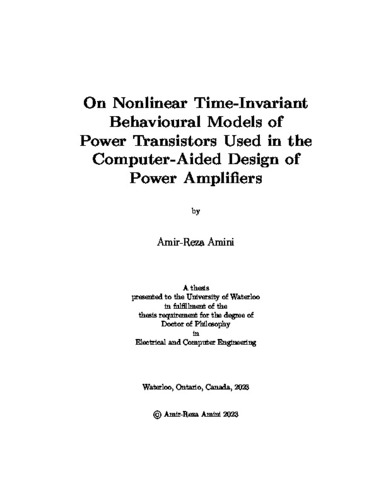| dc.contributor.author | Amini, Amir-Reza | |
| dc.date.accessioned | 2023-06-01 17:39:25 (GMT) | |
| dc.date.available | 2023-06-01 17:39:25 (GMT) | |
| dc.date.issued | 2023-06-01 | |
| dc.date.submitted | 2023-05-19 | |
| dc.identifier.uri | http://hdl.handle.net/10012/19517 | |
| dc.description.abstract | The Radio Frequency (RF) Power Amplifier (PA) is the main consumer of power in a wireless transmitter. Energy efficient PA design aided with circuit simulation tools requires accurate nonlinear models of the power transistors that lie at the heart of the PAs. This thesis proposes a novel methodology for extracting and implementing power transistor behavioral models from load-pull measurements. These models provide a valuable design aid to power amplifier designers looking to simulate the nonlinear behaviour of their RF circuit designs based on nonlinear characterizations of the power transistors.
Two types of power transistor behavioural models are proposed in this work. The first type is called the time-domain poly-harmonic distortion model (TD-PHD) and it targets the nonlinear multi-harmonic response of power transistors at a fixed fundamental frequency. This type of model allows the PA designer to simulate how the harmonic impedances of their designed RF matching networks effects the large signal behaviour of the PA. The TD-PHD model is shown to be able to replicate the time-domain waveforms of a power transistor under multi-harmonic source and load-pull characterization.
The second model is a generalization of the first model to target a set of non-uniformly spaced fundamental frequencies and is called the time-domain multi-tone distortion model (TD-MTD). Time-domain multi-tone distortion models that are extracted from load-pull measurements spanning multiple carrier frequencies are shown to recreate the load-pull performance contours of interest to PA designers. As a demonstration of TD-MTD models, two distinct behavioural models for the main and peaking transistors of a two-way Doherty PA design are extracted from load-pull measurements and the resulting PA design is then simulated and shown to accurately reflect the measured performance of the fabricated PA as a validation of the usefulness of this modelling methodology for high power amplifier design. | en |
| dc.language.iso | en | en |
| dc.publisher | University of Waterloo | en |
| dc.subject | rf power transistor modeling | en |
| dc.subject | behavioural modeling | en |
| dc.subject | time-domain modeling | en |
| dc.subject | nonlinear systems | en |
| dc.subject | power amplifier design | en |
| dc.title | On Nonlinear Time-Invariant Behavioural Models of Power Transistors Used in the Computer-Aided Design of Power Amplifiers | en |
| dc.type | Doctoral Thesis | en |
| dc.pending | false | |
| uws-etd.degree.department | Electrical and Computer Engineering | en |
| uws-etd.degree.discipline | Electrical and Computer Engineering | en |
| uws-etd.degree.grantor | University of Waterloo | en |
| uws-etd.degree | Doctor of Philosophy | en |
| uws-etd.embargo.terms | 0 | en |
| uws.contributor.advisor | Boumaiza, Slim | |
| uws.contributor.affiliation1 | Faculty of Engineering | en |
| uws.published.city | Waterloo | en |
| uws.published.country | Canada | en |
| uws.published.province | Ontario | en |
| uws.typeOfResource | Text | en |
| uws.peerReviewStatus | Unreviewed | en |
| uws.scholarLevel | Graduate | en |

